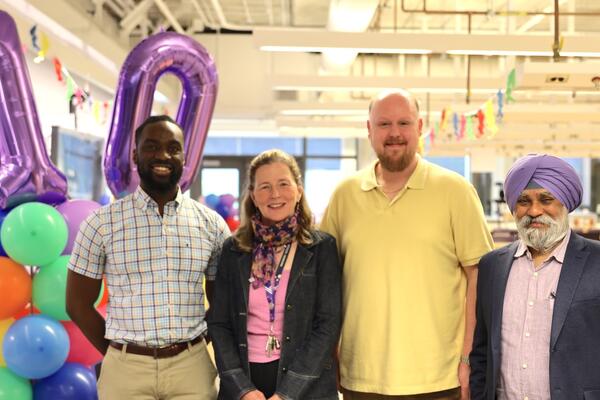
Launching future space explorers
Waterloo Indigenous student team have a blast at NASA’s rocket launch competition

Waterloo Indigenous student team have a blast at NASA’s rocket launch competition
By Charlotte Danby Faculty of EngineeringA team of five Indigenous students from the University of Waterloo participated in the First Nations Launch, an annual high-power rocket competition sponsored by NASA’s Wisconsin Space Grant Consortium (WSGC), designed to provide a unique aerospace learning experience.
It was the team’s first time taking part in the competition which involved designing, building and launching a high-powered model rocket carrying cargo to an apogee of 2000 feet. Months of hard work and invaluable support culminated in an epic — and windy — weekend in Kenosha, Wisconsin that everyone agrees, was a blast.
“We didn’t know what to expect going in,” says Matthieu Lavallee, a second-year chemical engineering student and Algonquin Anishinaabe member of the Wolf Lake First Nation in Québec.
“Each step was a massive learning curve which was great. There were lots of technical parameters we had to meet such as payload size and deployment timing, we also had some testing challenges as it isn’t possible to launch a high-powered rocket in Canada without proper authorization. But we had tons of support and nothing felt impossible.”
The nuts and bolts
The Waterloo team was one of three competing Canadian university teams in addition to 22 teams from the United States.
Mission critical components that contain explosive black powder like motors, ignitors and ejection charges were supplied on-site by the competition organizers. But the Canadian teams needed to source all the other rocketry building materials from structural items to the electronics and GPS, as well as cover the costs of transport and accommodation. This activity was undertaken with the financial support of the Canadian Space Agency (CSA).
The Waterloo team received additional funding from HATCH, an engineering professional services firm and long-standing co-op employer, the Waterloo Engineering Equity Fund which supports the representation, participation and inclusion of Black and Indigenous students in STEM, and the student-led Waterloo Engineering Endowment Foundation (WEEF).
The Waterloo Rocketry team also shared their time, skills and experience with the First Nations Launch team. Bill Graham, a retired software engineer with the Ottawa Rocketry Group, acted as the team’s technical mentor.
3..2..1..Liftoff!
Months of hard work backed by great supporters resulted in a six-foot high-powered rocket ready to launch. Everything was on track for a seamless weekend until the weather turned. With a day of high winds forecast, the competition organizers changed the rocket design parameters at the 11th hour. The team pulled a frantic (but fun) late night stint to modify the payload and refit the rocket.
Under the gaze of event attendees from United States space industry heavyweights including Blue Origin, the United States military’s Space Force and NASA, the Waterloo team launched their rocket successfully and celebrated its apogee of 786 feet.
The team’s Faculty advisors Andrew Milne, a continuing lecturer in the Department of Mechanical and Mechatronics Engineering, and Mary Robinson, associate dean of Outreach, Equity and Diversity, say it was a thrilling moment and they look forward to supporting next year’s team.
“It really is quite something to launch a rocket you’ve designed and built — we could see how awestruck the team was and we’re incredibly proud of them,” says Milne.
“The competition overall was very well-organized and the event itself did a great job of building community and promoting STEM education and innovation among Indigenous students,” adds Robinson. “We’ll be back in 2025 for sure.”
This year’s team was all Engineering students, but Milne and Robinson hope to encourage Indigenous students from other faculties to join the team for next year’s competition.
"I enjoyed this project for so many reasons,” Lavallee says. “I really liked that we could all try a bit of everything — from managing the budget to writing reports, programming, designing and building, event logistics and project management — there’s really something for everyone. But nothing beats seeing your rocket take off after months of hard work, I’ll never forget that rush.”
Feature image from left to right: Andrew Milne, Naomi Paul and Matthieu Lavallee with their rocket. Photo provided by Andrew Milne.

Read more
The Pearl Sullivan Engineering IDEAs Clinic marks a decade of delivering experiential learning embedded in the real world and mentored by industry professionals

Read more
Waterloo Engineering alum wears her iron ring proudly while building her career in quantum tech in Germany

Read more
Waterloo Engineering’s Sustainability and Social Entrepreneurship Fellowship program gives students access to real-world problems — and the tools to solve them
The University of Waterloo acknowledges that much of our work takes place on the traditional territory of the Neutral, Anishinaabeg, and Haudenosaunee peoples. Our main campus is situated on the Haldimand Tract, the land granted to the Six Nations that includes six miles on each side of the Grand River. Our active work toward reconciliation takes place across our campuses through research, learning, teaching, and community building, and is co-ordinated within the Office of Indigenous Relations.